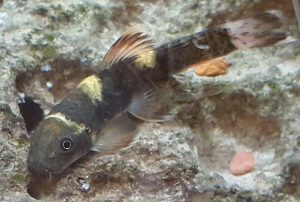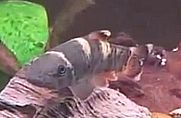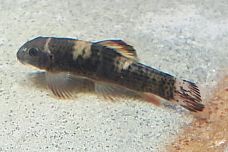The Panda Garra (Garra flavatra) or “Panda Loach” is endemic to the Rakhine Yoma/Arakan mountain range in Rakhine state, western Myanmar (Burma) and although incorrectly labeled as a loach; is often sold to tropical fish keeping enthusiasts as the Clown Loach, Panda Loach, Banded Butterfly Loach, or Rainbow Loach.
Although the Panda Garra and it’s related species are found predominately in the very shallow, clear, oxygen rich, streams of their range over substrates of mixed sand, gravel, pebbles and rocks; Garra flavatra have also been collected in relatively shallow, slow moving waters, with a number of specimens confined to almost stagnant pools.
In the Rakhine Yoma mountain range, Panda Garra were collected among Aplocheilus panchax, Puntius binduchitra, Rasbora daniconius, R. Rasbora, Olyra burmanica, Pterocryptis cf.
berdmorei, Sicyopterus fasciatus, Lepidocephalichthys berdmorei, Batasio elongatus and several unspecified Danio, Devario, Hara, Puntius, Parambassis, Pangio, Rasbora, and Schistura species.
Some of the other Garra specimens found in the same range of the Panda Garra includes Garra poecilura, which is the most similar to Garra flavatra in caudal fin pattern and body shape; Garra rakhinica, which has a comparable body shape but lacks the pretty caudal markings; Garra propulvinus and Garra vittatula, which are both an unremarkable, brown colored, laterally striped species ; Garra spilota, which has red fins, a coppery colored body with dark blue/gray blotches on the flanks; and Garra nigricolla, which is the larges of the species, distinguised by a dark stripe across the top of their head.
Garra flavatra is an attractive, active, entertaining species in the Cyprinidae family that contains over 100 recognized, but poorly documented species, most of which have never been seen by tropical fish keeping enthusiasts. Because of their interesting behavior and attractive coloring, the Panda Garra is easy to recognize and has become more available in the hobby.
The Panda Garra (Garra flavatra) is the only member of the Garra genus that has alternating dark and light brown to black vertical bars on the flanks, and red markings in the fins.
Like all Garraina, they posess a modified lower lip that forms a somewhat adhesive disk that they use in turbulent waters to cling to the substrate while feeding.
In most species, the upper lip is almost absent, and both upper and lower jaws are keratinised (horny) and used to scrape food from the substrate.
Panda Garra are best kept in groups of 5 or more specimens, preferably in a biotope “hill stream” type community setting with other specimens collected from their range.
Garra flavatra should be housed in a well matured tank of at least 20 gallon capacity, with a mixed sand, gravel, pebble, and rock substrate, some driftwood branches, and a few hardy plants like Anubias spp., Bolbitis, or Microsorum attached to the rocks for decoration. They need clean, well oxygenated water with a turnover of at least 10 times per hour, and regular water changes to keep them healthy and active.
An outside canister type filtration system with a powerhead and/or air stone is highly recommended to provide the necessary current and oxygenation.
Panda Garra have been known to “climb” from the tank if water conditions are not to their liking, so a tightly fitting cover is also recommended.
The Panda Garra has been bred in an aquarium environment and at least two Myanmar exporters have been supplying the aquarium trade since 2008.
Adult specimens are collected during their natural breeding season which occurs from May to July.
Adults are housed together in large breeding tanks and conditioned with chopped earthworms, live Tubifex, and an algae rich diet. The males develop turercules on their head when ready to spawn, and the females become noticeably gravid. Breeders normally remove individual pairs at this stage and transfer them to smaller, highly oxygenated tanks with a moderate current.
Eggs are laid in the morning and hatch within 24 to 30 hours. The fry are free swimming shortly thereafter and can be fed liquid fry food or a suspension made from egg yolk until they are large enough to accept newly hatched brine shrimp, usually in a week or so. Continuous flowing water is believed to stimulate feeding and the growth rate of the fry.
In their natural environment adult Panda Garra graze on algae and other organisms from rocks with epilithic growth. In an aquarium environment, they should be offered meaty foods such as live, frozen, or freeze dried bloodworms, Tubifex, brine shrimp, chopped prawn, chopped earthworms
, etc. along with a quality sinking wafer containing vegetable matter or Spirulina
.
They appreciate occasional treats of blanched spinach, melon, cucumber, and other fresh vegetables. A river rock with live organisms placed in their tank on a regular basis is also readily appreciated.
Panda Garra are not common in tropical fish keeping shops and when available are usually misidentified as Panda Loaches, etc. They are occasionally available online from importers in various sizes during their breeding season at relatively reasonable prices.
Minimum Tank Size: 20 gallons
Care Level: Moderate
Temperament: Peaceful
Aquarium Hardiness: Moderately Hardy
Water Conditions: 71.6 – 81F , 2-12 dKH, pH 6.5-7.5
Max. Size: 3.5″
Color Form: Brown, Tan
Diet: Omnivorous
Compatibility: Bio-tope and peaceful community
Origin: Myanmar
Family: Cyprinidae
Life Span: 5-6 years
Aquarist Experience Level: Intermediate





